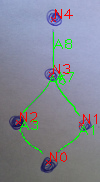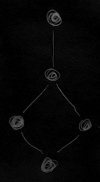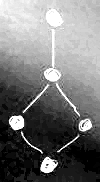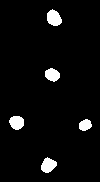I would suggest to do better preprocessing because of non uniform background and to avoid blur because thin arcs can disappear.
When you have a good mask for your drawing you can use massive morphology operation to isolate nodes and arcs
Finally you have to design a logic to build the chart connections.
edit: small changes in descriptions
Below is my DiagramAnalyzer to convert your image into a Graphviz/dot chart. Here is the result
graph G{
N0 N1 N2 N3 N4
N1 -- N0
N2 -- N0
N3 -- N2
N3 -- N1
N4 -- N3
}
Enumerating:  Layout by Graphviz/dot
Layout by Graphviz/dot 
int DiagramAnalyzer()
{
Mat src, bw;
src = imread("../img/diagram-x5.jpg");
==PREPROCESSING==
Option1: Remove non uniform background/illumination. You can achieve this using the wonderful quadratic background removal by @LBerger. Than get a mask of the drawing using a simple threshold
#if 1
Mat srcGray, dstGray;
cvtColor(src, srcGray, CV_BGR2GRAY);
BackgroundRemoveQuadratic(srcGray, dstGray);
threshold(dstGray, bw, 100, 255, THRESH_OTSU);
Quadratic result  threshold
threshold 
OR Option2: Get the HSV planes and threshold high values in S (>=95 percentile) to get a mask of the drawing. You can achieve this using clipHistPercent=5 with BrightnessAndContrastAuto than get a binary mask looking at very high values in saturation
#else
Mat src_hsv, saturation;
vector<cv::Mat> hsv_planes;
cvtColor(src, src_hsv, CV_BGR2HSV);
cv::split(src_hsv, hsv_planes);
saturation = hsv_planes[1];
BrightnessAndContrastAuto(saturation, saturation, 5);
bw = saturation >= 254;
#endif
Saturation result (look at values of drawing)  threshold
threshold 
fill circular structures using small circle
int nodeSize = 15; //avg node diameter in px
Morph(bw, bw, MORPH_CLOSE, MORPH_ELLIPSE, cvRound(nodeSize / 5));
imshow("Preprocessing", bw);
 Preprocessing (result of quadratic)
Preprocessing (result of quadratic)
GET MASK OF NODES: remove boundary structures smaller than nodeSize . Should remove the arcs
cv::Mat nodesMask;
Morph(bw, nodesMask, MORPH_OPEN, MORPH_ELLIPSE, cvRound(nodeSize / 5));
imshow("Nodes-Mask", nodesMask);
 Node Mask
Node Mask
GET MASK OF ARCS: dilate nodes a bit (ensure node vs arcs separation) than subtract them from the global mask
cv::Mat arcs, nodesLarger;
Morph(nodesMask, nodesLarger, MORPH_DILATE, MORPH_ELLIPSE, 1);
arcs = bw - nodesLarger;
imshow("Arcs-Mask", arcs);
 Arcs Mask
Arcs Mask
GET INTERSECTIONS: ensure node vs arcs intersection doubling size of nodes than get a mask of shared pixels
cv::Mat intersections;
Morph(nodesLarger, nodesLarger, MORPH_DILATE, MORPH_ELLIPSE, nodeSize);
intersections = nodesLarger & arcs;
GET CONTOURS OF ELEMENTS
vector<vector<Point> > nodesContours, arcsContours, intesectsContours;
findContours(nodesLarger, nodesContours, CV_RETR_EXTERNAL, CHAIN_APPROX_SIMPLE);
findContours(arcs, arcsContours, CV_RETR_EXTERNAL, CHAIN_APPROX_SIMPLE);
findContours(intersections, intesectsContours, CV_RETR_EXTERNAL, CHAIN_APPROX_SIMPLE);
vector<Point> nodesCenter(nodesContours.size(), Point(-1, -1));
vector<double> nodesArea(nodesContours.size(), -1);
vector<double> arcsLenght(arcsContours.size(), -1);
DRAW ENUMERATED CONTOURS and get center of nodes
Moments m;
Point center;
Scalar cl = Scalar(0, 0, 255);
double val,minvalue = nodeSize/3;
for (size_t i = 0; i < nodesContours.size(); i++)
{
val = contourArea(nodesContours[i]);
if (val < minvalue) continue; //skip if it's small
nodesArea[i] = val;
m = moments(nodesContours[i], true);
//if (m.m00 == 0) continue;
center = Point(m.m10 / m.m00, m.m01 / m.m00);
nodesCenter[i] = center;
drawMarker(src, center, cl, MARKER_TILTED_CROSS, 5);
putText(src, "N" + to_string(i), center, FONT_HERSHEY_PLAIN, 1, cl);
}
cl = Scalar(0, 255, 0);
minvalue = nodeSize/5 ...
(more)


 Layout by Graphviz/dot
Layout by Graphviz/dot 
 threshold
threshold 
 threshold
threshold 
 Preprocessing (result of quadratic)
Preprocessing (result of quadratic) Node Mask
Node Mask Arcs Mask
Arcs Mask
Ow wait, some pointers
adaptive gaussian thresholdplease forget this. Go for a simple binary OTSU thresholding. There is a clear difference between the color of the background and the color of the writings so it should go fairly easy.You can't use OTSU threshold here. OTSU minimizes the intra-class variance... in binary thresholding it uses just 2 classes. Here background histogram is so spread due to non uniform illumination and the tenuous foreground signal is lost within 2 main classes. More simply, take a look at grayscale histogram... there aren't 2 peaks (class) for fg and bk that's why OTSU can't works
this is coming in my mind ;-)